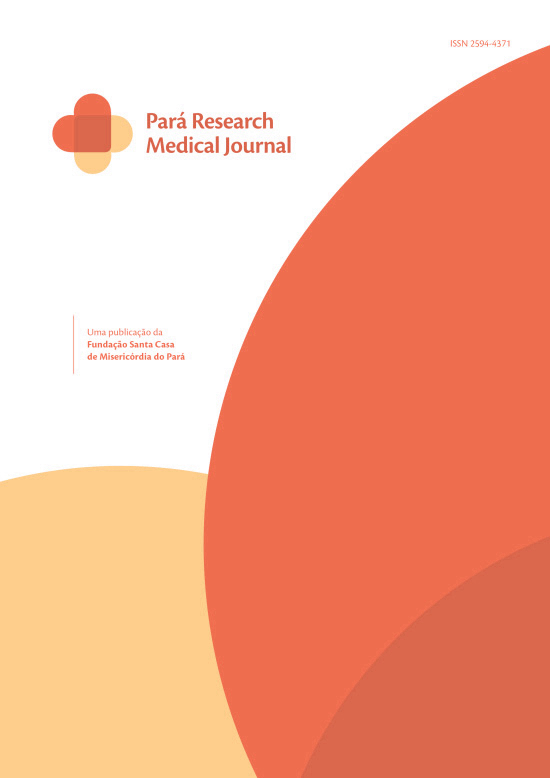Frequency of red blood cells antibodies in possible cases of hemolytic disease of the newborn laboratory evidenced at Hemopa
DOI:
https://doi.org/10.5327/prmj.2021.008Keywords:
anemia, hemolytic, pregnancy, high-risk, erythrocytesAbstract
Purpose: To describe the frequency of red blood cells antibodies possibly related to Hemolytic Disease of the Newborn cases reported laboratory evidenced at Fundação Centro de Hemoterapia e Hematologia do Pará. Methods: This is a descriptive, cross-sectional study, based on the analysis of immuno-hematological reports of newborns filed at the Immunohematology Laboratory of the Fundação Centro de Hemoterapia e Hematologia do Pará , released between January 2015 and December 2019. The obtained data are related to ABO/Rh(D) typing; Direct Antiglobulin test; Irregular Antibodies test; Eluate, which were transcribed to Microsoft Excel sheets for later descriptive analysis. The study was approved by the Research Ethics Committee of the Fundação Pública Estadual do Hospital das Clínicas Gaspar Vianna, under the legal opinion #3,435,869. Results: A total of 37 reports were analyzed, laboratory evidence showed 34 cases of positive Direct Antiglobulin Test, of these, 22 presented positive eluate test. The highest frequency of described cases was related to anti-D antibody (19/22; 86.4%), followed by anti-c (1/22; 4.5%) and clinically significant antibody associations (2/22; 9.1%). Conclusion: The most frequent alloantibody evidenced was anti-D, however, other red blood cells alloantibodies observed drew attention and were considered relevant scientific evidence regarding the subject.
Downloads
References
Nassar GN, Wehbe C. Erythroblastosis Fetalis. Treasure Island: StatPearls Publishing; 2022.
Hoffbrand AV, Moss PAH. Fundamentos em hematologia de Hoffbrand. Porto Alegre: Artmed; 2018.
Girello AL, Kühn TIB de B. Fundamentos da imuno-hematologia eritrocitária. São Paulo: Editora Senac São Paulo; 2016.
Baiochi, E, Nardozza, LMM. Aloimunização. Rev Bras Ginecol Obstet. 2009;31(6):311-9. https://doi.org/10.1590/S0100-72032009000600008
Bennardello F, Coluzzi S, Curciarello G, Todros T, Villa S; Italian Society of Transfusion Medicine and Immunohaematology (SIMTI) and Italian Society of Gynaecology and Obstetrics (SIGO) working group. Recommendations for the prevention and treatment of haemolytic disease of the foetus and newborn. Blood Transfus. 2015;13(1):109-34. https://doi.org/10.2450/2014.0119-14
Kahar M. Frequency of Red Cell Alloantibodies in Pregnant Females of Navsari District: An Experience that Favours Inclusion of Screening for Irregular Erythrocyte Antibody in Routine Antenatal Testing Profile. J Obstet Gynaecol India. 2018;68(4):300-5. https://doi.org/10.1007/s13224-017-0984-5
Chatziantoniou V, Heeney N, Maggs T, Rozette C, Fountain C, Watts T, et al. A descriptive single-centre experience of the management and outcome of maternal alloantibodies in pregnancy. Transfus Med. 2017;27(4):275-85. https://doi.org/10.1111/tme.12430
Yoda M, Hosono S, Nagano N, Yoshikawa K, Takahashi S. Hemolytic disease of the newborn due to anti-E and anti-c antibody following maternal transfusion. Pediatr Int. 2017;59(10):1093-4. https://doi.org/10.1111/ped.13372
Peeters B, Geerts I, Badts AM, Saegeman V, Moerman J. Usefulness of maternal red cell antibodies to predict hemolytic disease of the fetus and newborn and significant neonatal hyperbilirubinemia: a retrospective study. Clin Chem Lab Med. 2017;55(9):e202-5. https://doi.org/10.1515/cclm-2016-0545
Slootweg YM, Lindenburg IT, Koelewijn JM, Van Kamp IL, Oepkes D, De Haas M. Predicting anti-Kell-mediated hemolytic disease of the fetus and newborn: diagnostic accuracy of laboratory management. Am J Obstet Gynecol. 2018;219(4):393.e1-8. https://doi.org/10.1016/j.ajog.2018.07.020
Wagner T, Resch B, Reiterer F, Gassner C, Lanzer G. Pancytopenia due to suppressed hematopoiesis in a case of fatal hemolytic disease of the newborn associated with anti-K supported by molecular K1 typing. J Pediatr Hematol Oncol. 2004;26(1):13-5. https://doi.org/10.1097/00043426-200401000-00005
Reche GM, Paula Júnior MR. Determinação da frequência de anticorpos ABO e Rh maternos em recém-nascidos.Univ Ci Saúde. 2014;12(2):77-82. https://doi.org/10.5102/ucs.v12i2.2871
Baiochi E, Camano l, Sass N, Colas OR. Frequências dos grupos sanguíneos e incompatibilidades ABO e RhD em puérperas e seus recém-nascidos. Rev Assoc Med Bras. 2007;53(1):44-6. https://doi.org/10.1590/S0104-42302007000100018
Jain A, Kumawat V, Marwaha N. Blocked D phenomenon and relevance of maternal serologic testing. Immunohematology. 2015;31(3):116-8. PMID: 26829177
Siqueira MLB, Oliveira UGL, Bordin RO, Amaral BAR, Alves SM, Medeiros MO. Perfil etário e sanguíneo da população gestantes atendidas pela Unidade Municipal de Saúde de Rondonópolis, MT. Biodiversidade. 2016;15(3):98-110.
Moinuddin I, Fletcher C, Millward P. Prevalence and specificity of clinically significant red cell alloantibodies in pregnant women – a study from a tertiary care hospital in Southeast Michigan. J Blood Med. 2019;10:283-9. https://doi.org/10.2147/JBM.S214118
Das S, Shastry S, Rai L, Baliga PB. Frequency and clinical significance of red cell antibodies in pregnancy – a prospective study from India. Indian J Pathol Microbiol. 2020 Apr-Jun;63(2):241-246. https://doi.org/10.4103/IJPM.IJPM_737_19
Brazil. Departamento de Ações Programáticas Estratégicas. Gestação de alto risco: manual técnico. Brasília: Editora MS; 2012.




